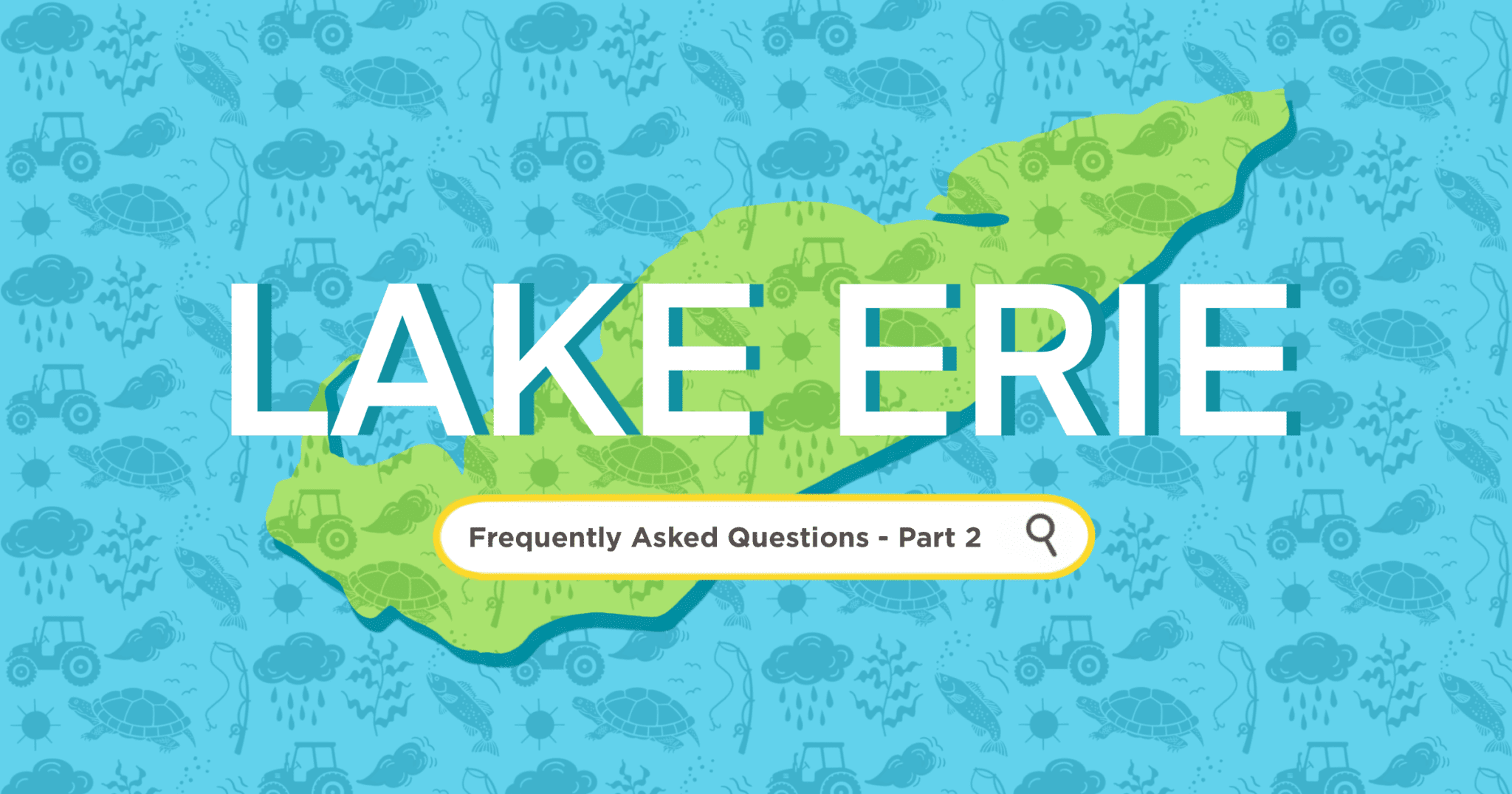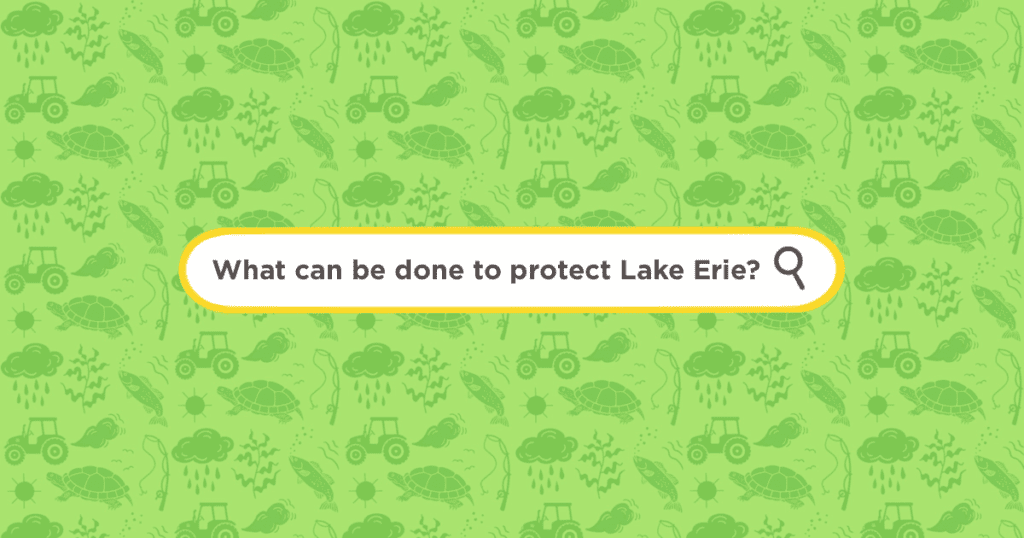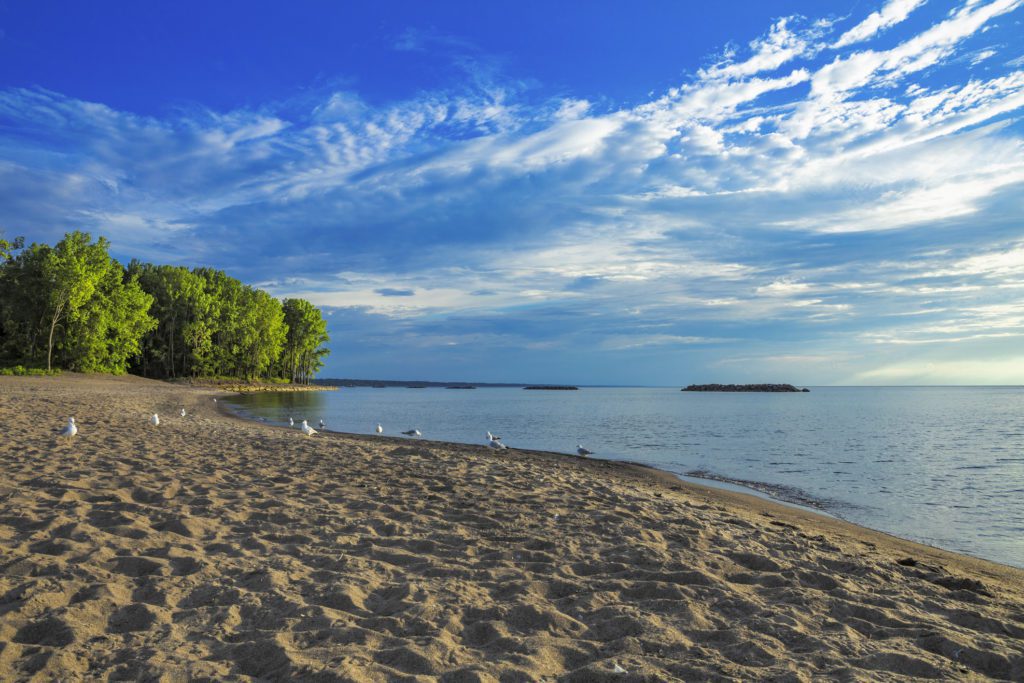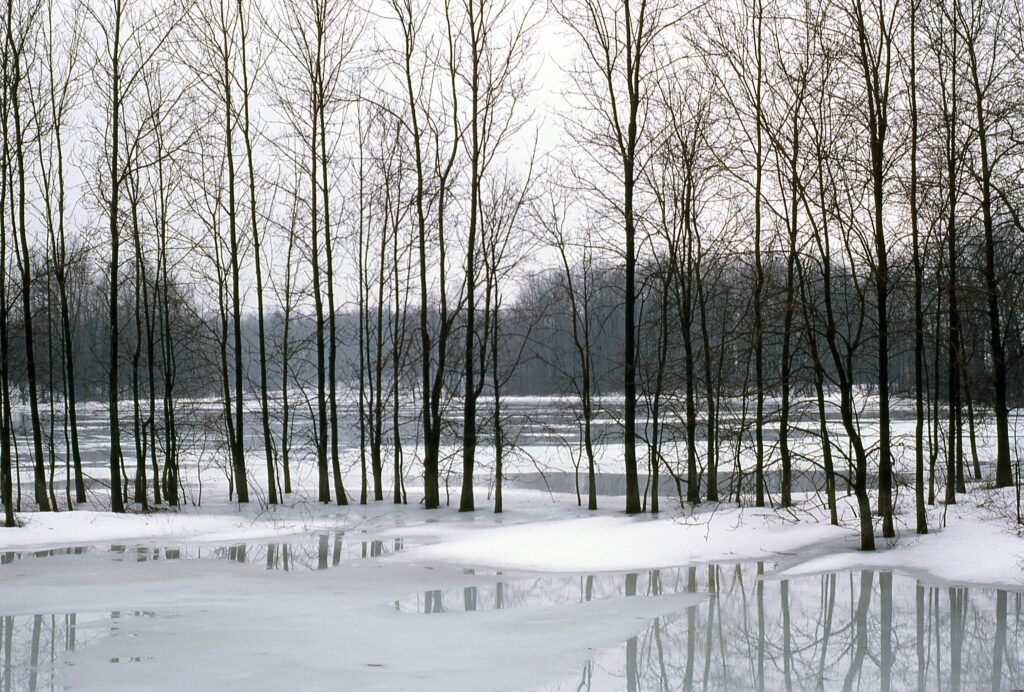This blog is co-authored with Michelle Woodhouse, Water Program Manager
Why is Lake Erie especially at risk?
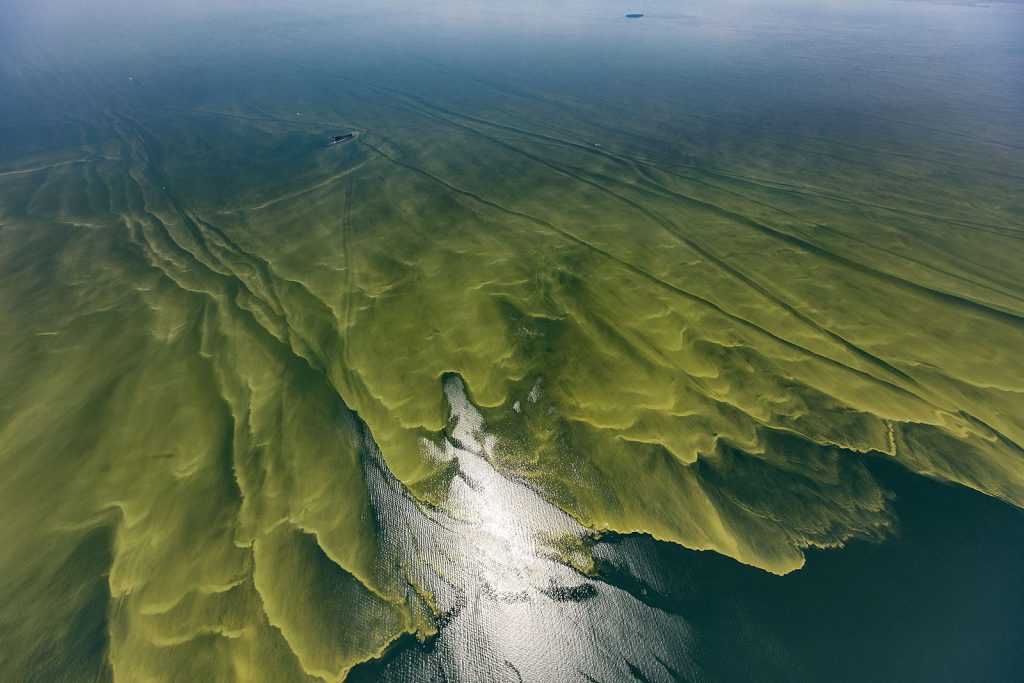
Photo Credit: Aerial Associates Photography, Inc. by Zachary Haslick
History of Lake Erie pollution
In the 1960s, Lake Erie suffered from extreme pollution due to industrial waste and sewage runoff, and parts of the lake were declared dead. The water quality was so bad that there were incidents where tributary rivers that empty into Lake Erie caught fire. These deplorable conditions eventually led to the implementation of the Clean Water Act, which was passed in 1972 and strengthened regulations on industrial waste disposal. The lake rebounded and was no longer considered dead. However, Lake Erie is now facing several new issues that threaten its ecosystems and water quality.
Lake Erie’s structure and position
Lake Erie is especially susceptible to pollution and climate change due to the same qualities that make it so diverse – it is shallow and warm. Lake Erie is also subjected to the largest amount of urbanization, industrialization, and agriculture, which leads to pollution and an excess of nutrients (this is called eutrophication).
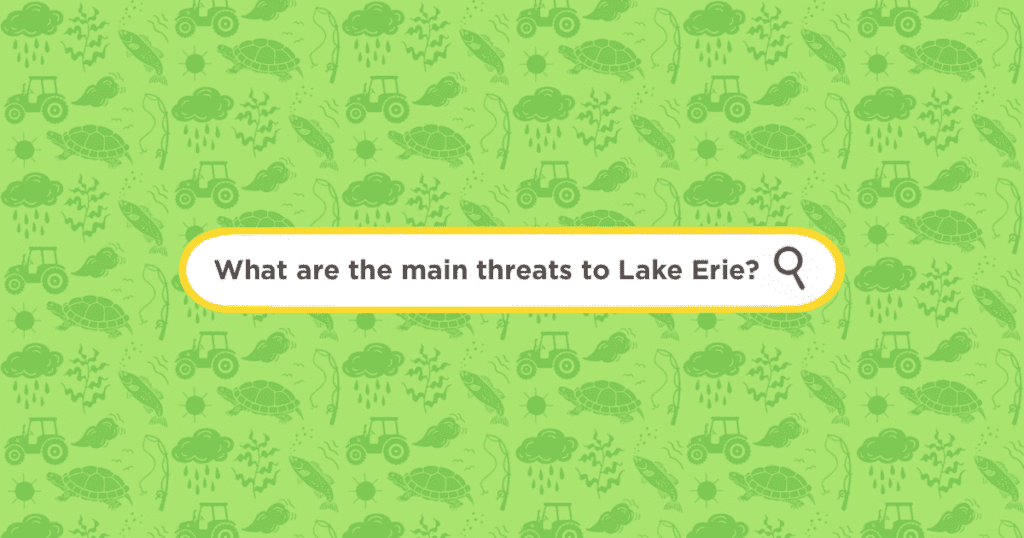
- Nutrient pollution and resulting algae blooms
- Climate change
- Road salt
- Plastic pollution
- Invasive species
Nutrient Pollution (Eutrophication)
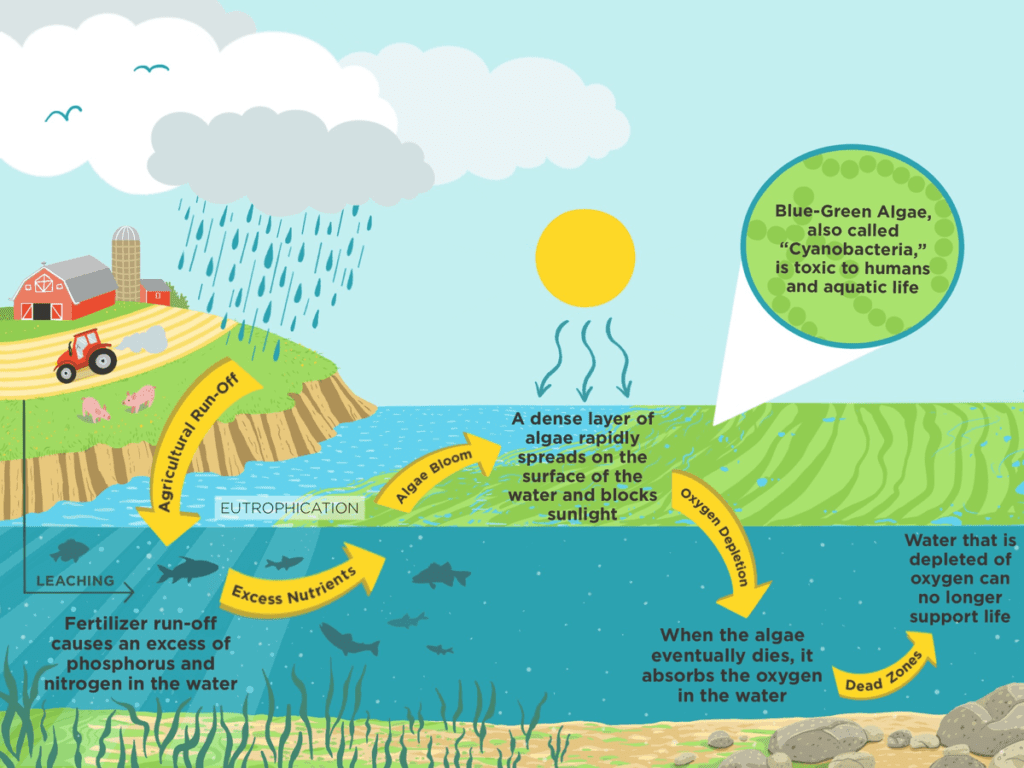
Lake Erie is experiencing severe, annual toxic algae blooms that are primarily caused by nutrient pollution in the form of excess phosphorus from agricultural fertilizer. Algae are a natural and critical part of aquatic food webs; however, when they become overgrown, they can turn into harmful algae blooms (HABs), which wreak havoc on the ecosystem by blocking sunlight, consuming the lake’s available oxygen and producing dangerous toxins. Warmer temperatures, severe rainfall and excessive nutrients can cause algae blooms to grow larger and more severe.
HABs often produce toxins that are harmful to both humans and animals. Cyanobacteria (often referred to as blue-green algae) are the most common type of HAB in freshwater lakes.
What is a Deadzone?
When the algae from severe algae blooms start to die and decompose, they consume the available oxygen in the water. This completely suffocates the lake, creating what is known as a “dead zone” due to a lack of oxygen in the water. Dead zones can decimate fisheries and kill other forms of aquatic life.
Climate Change
As the air and water temperatures increase, evaporation from Lake Erie also increases, which lowers the water levels and deteriorates the water quality. Climate change will exacerbate the existing threats to Lake Erie by making the lake more hospitable for invasive species, disturbing sediment that contains harmful chemicals, drying coastal wetlands that would otherwise filter pollution and increasing the frequency and severity of storms, which leads to increased sewage and agricultural runoff.
Road Salt
Chloride pollution (usually the result of excessive road salt) has become a serious issue for the Great Lakes and other freshwater bodies in Canada. A study conducted by the University of Toronto in 2021 found that nearly 90% of water samples taken from our rivers, even in the summertime, exceeded federal guidelines for chloride levels in the water. High salt levels threaten aquatic species that cannot survive in salty water.
Alternatives are necessary to manage icy surfaces during the colder months.
Plastic Pollution
The Great Lakes have a higher concentration of plastic pollution than the ocean garbage patches. In fact, more than 10,000 tonnes of plastic waste is dumped in the lakes each year (that’s the weight of the Eiffel Tower).
Plastics break down into something called microplastics, which can obstruct animals’ digestive tracts and leak toxic chemicals that are then absorbed into animals’ bodies. Microplastics then bioaccumulate as they make their way up the food chain into humans.
Microplastics have been found in our drinking water and food. These plastics are full of toxic additives, including endocrine-disrupting chemicals (bisphenols, phthalates, brominated flame retardants, PFAs and heavy metals). Plastic particles have been found in human blood, lungs, placenta and breast milk.
Invasive Species
More than 180 invasive plant and animal species have infested the Great Lakes in the past 200 years. Lake Erie is plagued with many harmful invasive species, including the goby, water fleas, grass carp, zebra mussels and sea lampreys. These invaders compete with native species for food and shelter, harm fisheries, clog infrastructure and even lead to the regional extinction of some species.
Canada-Ontario Agreement on Great Lakes Water Quality and Ecosystem Health
In February 2018, the federal and provincial governments released a joint action plan to address the nutrient pollution problem in the Great Lakes. In the most recent Canada-Ontario Agreement on Great Lakes Water Quality and Ecosystem Health, the government identified priority watersheds where phosphorus management plans are most needed. It’s also currently monitoring the rivers and streams that flow into Lake Erie to measure how much phosphorus is making its way into the Lake from these sources. But measuring our progress remains challenging when it comes to agriculture – one of the primary sources of all this phosphorus. So far, voluntary programs aimed at helping farmers reduce the amount of phosphorus running into the lake from their farms have not seen great uptake.
Ontario has committed to reducing phosphorus levels by 40 per cent by 2025, but it’s unclear how the government is going to meet this target and how it plans to measure progress. The provincial and federal governments must continue to work together on this and need to be more transparent and accountable to the public. In order to avoid billions of dollars of damage in future years, our governments must address environmentally harmful farming practices. We also need to see more green and natural infrastructure being implemented across our city landscapes.
Steps forward
The issues facing Lake Erie are complex, and they require a multitude of different individuals, groups, and levels of government to work together toward a common goal. This isn’t always easy to achieve when there are competing interests at play. But Lake Erie is one of the most precious freshwater lakes in the world that Canadians depend upon for drinking water, food production, livelihoods, recreation, cultural and spiritual connection, and much more. It needs to be protected.
Tell the federal and provincial governments to stop delaying and put their plan to work to Save Lake Erie.




